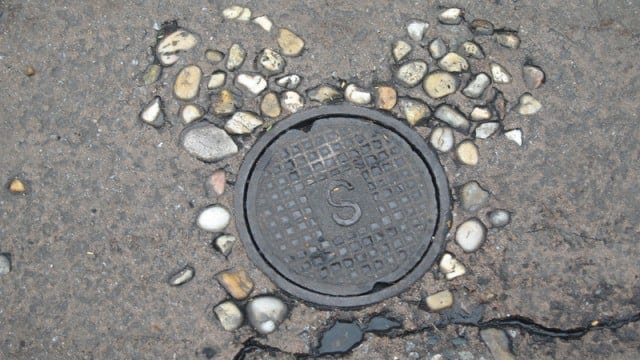My house is five miles from Disneyland “as the crow flies.” We hear the fireworks every night in our living room. If we climbed up on our roof, we could watch the fireworks.
But here’s the thing, and I want to be clear about this:
I hate Disneyland.
Given that I am a philosophy professor at a Christian university concerned about things like anthropology and formation, you might expect my hatred to be born of high-minded motivations related to problematic worldview influences, or entertainment culture, or the implicit liturgy of the daily parade down Main Street.
I don’t care about any of that.1 Disneyland, in my view, is a horror.
Just one example. One time, at the end of a long hot day of park-hopping, my wife and I took our two at-that-time-small children on It’s a Small World. By the end—trapped on those tiny boats in the darkness of an unending cave the people at Disney call “a ride,” as the oldest, basically immobile dolls with their strange eyes and mechanically movable lower jaws dissonantly chanted about the tininess of the world that I was by then struggling to remember existed outside of the nightmare I had been floating through for what felt like seven hours—I came to know some things with a certainty I’ve rarely felt:
These ancient dolls are Satan’s spawn, birthed in the darkness of time from Leviathan’s terrible wrath; they are hell-bent on delivering me to a fate worse than death; and—have I mentioned this?—
I hate Disneyland.
My family disagrees with me about It’s a Small World and about Disneyland more generally. They love it. I explain to them my clear-eyed vision regarding the dolls and their origins and designs. They laugh at me, and stubbornly attribute this to some childhood trauma or a personality “quirk” or some such thing, rather than to the work of the Spirit in me. “The dolls aren’t out for your soul,” they say. Thing is, though, they are. I saw the intentions of their shriveled black hearts.
What’s a prophet to do when faced with such blatant gaslighting?
Become a chauffeur, that’s what.
I am now merely a driver vis-á-vis the park. Why pay for parking when a conduit of new revelation is willing to drop you off and pick you up at Downtown Disney? Everyone is happier this way. I just have to look the other way—and pray—while my family subjects themselves to grave, imminent danger during the rare days they traipse through the outer bands of the influence of the dolls.2
On the other hand, I’m a philosopher. And so I always wonder, what can we learn from Disney about the way the world works?
The answer to this question is: quite a bit, actually. Not from the dolls, of course. When they speak the truth, they do so only to lead people to destruction or despair. But from other things we can learn.
Before we carry on with Disney, I need to introduce a philosophical problem borne of a devotional one. In the past quarter century, a philosopher named J. L. Schellenberg has pushed an argument that begins with the fact that people don’t believe in God and concludes that God doesn’t exist. This is often called the “hiddenness argument” or the “argument from nonbelief.”
As you would expect, there are claims intermediate between people don’t believe in God and God doesn’t exist. First, there is the idea that God is omnibenevolent, that He is perfectly and maximally loving. Second, there is the idea that God’s omnibenevolence would prevent him from allowing people to disbelieve in Him. After all, loving union with God is the best life possible and so God would want that for all of His creatures, and belief in God’s existence is required for loving union with God. In other words, because God is omnibenevolent, He would make His existence undeniable to His creatures, since we must believe He exists in order to love Him back.
These three claims—an omnibenevolent God exists, God’s omnibenevolence rules out nonbelief, and there are nonbelievers—are inconsistent. They can’t all be true together. The hiddenness argument asks us to conclude that there is no omnibenevolent God.3
You won’t be surprised to learn that I reject a different member of the triad: the claim that God’s omnibenevolence rules out nonbelief. There are a number of ways to resist. Here, we’ll focus on just one way:
The traces that persons leave in the world are easy to miss—even to mistake for the residue of non-personal forces.
Thus we arrive back to Disneyland, to the phenomenon of “Hidden Mickeys.” A Hidden Mickey, according to one professional Hidden Mickey hunter, is “a partial or complete image of Mickey Mouse that has been hidden by Disney’s Imagineers and artists in the designs of Disney attractions, hotels, restaurants, and other areas.”4 There are tons of these. Some are fairly obvious, like these:
Some are bit more subtle, but still fairly clear:
Some are obvious, but the vantage point you need to find them is almost impossible to achieve:
Some are tricky to discern even if you’re Hidden Mickey hunting:
Looking at any of these images, and knowing that Disney employees often embed Hidden Mickeys on Disney properties, it is fairly clear that these are left on purpose, by design, through the intentional choices of conscious agents. There can be little doubt that these really are Hidden Mickeys. Take the last image, for example: given how meticulously Disney maintains its properties, it strains credulity to imagine that the worn away concrete is an accident. Disney wants those rocks to be visible.
However, things aren’t always so clear. Take the Once Upon a Toy store in Disney Springs, near Disney World. Here is the entrance:
Atop the pillars composed of oversized Lincoln Logs are Tonka-style dump trucks. The final log, together with the truck tires, compose a three-circle cluster that bears some resemblance to a Mickey-head outline. Many count these among the Hidden Mickeys.
But it’s not obvious that these are Hidden Mickeys. To be a Hidden Mickey requires being hidden: that is, this arrangement would have needed to result from some Imagineers intending to image Mickey through the arrangement. So it’s possible these are Hidden Mickeys. But it’s equally possible that they aren’t. Indeed, there are plausible stories to tell, at least without further information about the design of the store’s façade, on which this is just accidental. For example, it’s possible that the person who decided to cap those pillars with Tonka trucks just thought it would be a whimsical yet fitting addition, and that perching the trucks with wheels straddling the topmost log would allow them to stay in place without further attachment. Maybe the person who designed these pillars had never even heard of Hidden Mickeys.
The fact is we just don’t know. And so while it might be rational for someone to believe that this arrangement is a Hidden Mickey, it might be rational for another to deny it.
This is so despite that the physical trace itself—its existence, its form, even its underlying physical nature—is not at all in dispute. The question is not whether there’s a Tonka truck atop a Lincoln log. The question is whether that arrangement is a Hidden Mickey.
This points to an important truth: the traces intentional agents leave in the world are ambiguous in two senses. First, the same traces can sometimes come about by accidental actions of agents and even by entirely impersonal forces. A chaos of Legos in the den might have come about by a child’s fit, by a thwarted attempt at organization, by the family puppy, or by an earthquake that caused the Millennium Falcon to fall from the shelf.
Second, sometimes reasonable people can disagree about whether some aspect of the world was left behind by the intentional action of a person. Often this will happen when we lack relevant information about the circumstances by which the trace came to be. If you don’t know whether an earthquake occurred recently, it’s difficult to evaluate the claim that the chaos of Legos resulted from an earthquake!
What is particularly striking is that it is almost impossible for an agent to produce an effect that could only be caused by the agent him- or herself. Very little of what we leave behind in the world is in principle something that only we could leave behind. Almost always, there could be other explanations.
This is true no less with Hidden Mickeys and our mortal activities than with the activities of God. One of the challenges of the Christian life is discerning whether an inner impetus to act is coming from God, from oneself, or from somewhere else. Whether the piece of advice from a friend or even a stranger is a message from God. Whether a particular event is or is not a bit of divine judgment.
So I find implausible the idea that an omnibenevolent God would, or perhaps even could, entirely rule out unbelief. This becomes all the more clear when we incorporate the fact that God invites us to believe not only that He exists but that He is personal. The personhood of God can be discerned only in traces that might have been produced by others or even by chance. Further, perhaps God’s respect for our status as persons means he will refuse to overwhelm us. C. S. Lewis hints at this in The Screwtape Letters:
You [Wormwood] must have often wondered why the Enemy [God] does not make more use of His power to be sensibly present to human souls in any degree He chooses and at any moment. But you now see that the Irresistible and the Indisputable are the two weapons which the very nature of His scheme forbids Him to use. Merely to override a human will (as His felt presence in any but the faintest and most mitigated degree would certainly do) would be for Him useless. He cannot ravish. He can only woo. For His ignoble idea is to eat the cake and have it; the creatures are to be one with Him, but yet themselves.5
In inviting us, as rational agents, into personal relationship with Him, God therefore asks us to believe on the basis of evidence that is both obvious to our eyes and ambiguous.
Now that I think about it, perhaps my experience of the dolls has a source other than a vision from God. Perhaps I should rethink my view of Disneyland…
This post is recasting part of an argument my friend Robert Garcia and I make in “Hidden Mickeys and the Hiddenness of God.” You can find that paper in Disney and Philosophy but also reprinted in the second edition of Introducing Philosophy through Pop Culture.
This is overstated. Did you forget you were on the internet?
I hope it goes without saying that the vigor I am claiming for my feelings about Disneyland is tongue in cheek. And to be clear: my son agrees with me, against my wife and daughter, about the dolls, but he disagrees about Disneyland more generally.
As you might expect, there are subtleties and details I’ve suppressed. But this is, I hope, enough to get the gist, and none of the suppressed bits will be relevant to what I have to say below.
Steven Barnett, Disneyland’s Hidden Mickeys, 6th edition, p. 9.
p. 39 of the 2001 HarperCollins edition.











I was here for the Disneyland bashing, but stayed for the philosophical analysis.
I remember going on the Small World ride in Florida as a teenager and thinking, "really? really????"
It's a Small World is a cool delight on a hot day and is, and will remain, one of my favorite rides. You've got so many problems. Too many to unpack here.